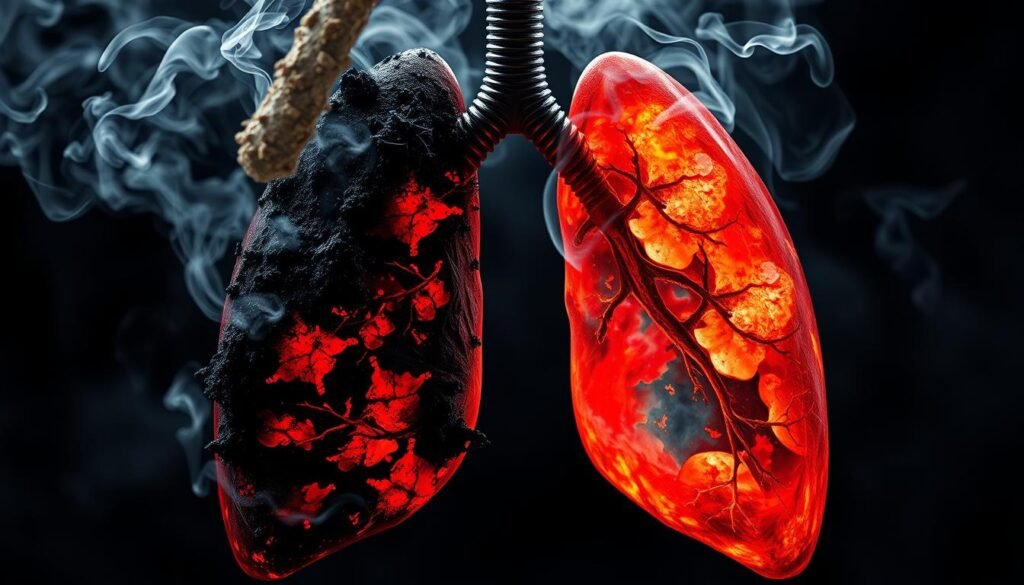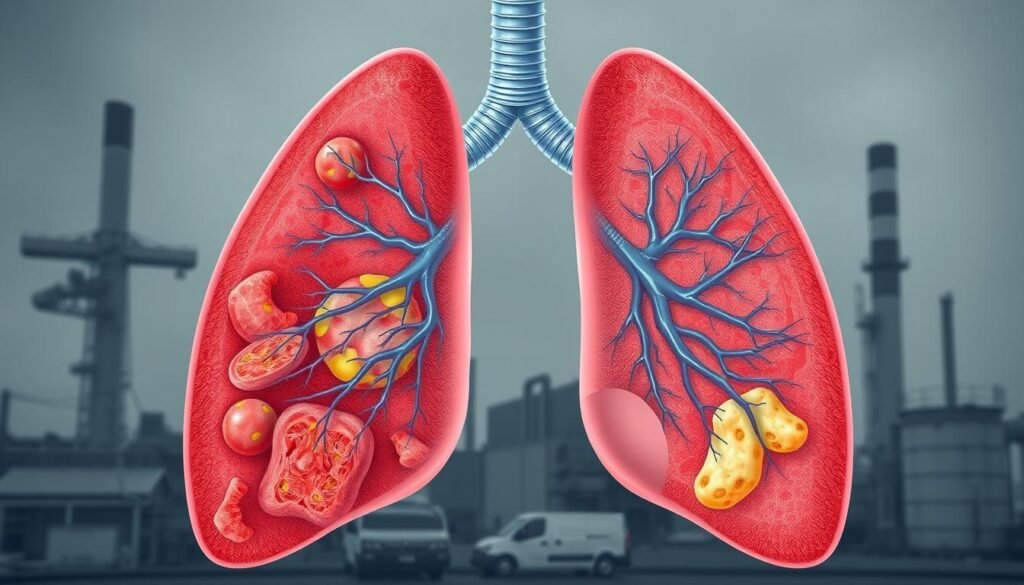Did you know being around asbestos increases lung cancer risk by 10 times? This scary fact has been known since the 1930s. Asbestos is a known cancer-causer. But if you smoke and are around asbestos, the risk soars. Smokers with asbestos exposure can face a death rate 36.8 times higher, especially if they have asbestosis. It’s vital to understand how smoking and asbestos play roles in lung cancer. This article will explore the dangers of both, alone and together.
Key Takeaways
- Asbestos exposure has been linked to lung cancer since the 1930s.
- Combined smoking and asbestos exposure significantly increase lung cancer risk.
- Occupational asbestos exposure alone is associated with a death rate 5 times higher than average.
- Smoking contributes to 80% to 90% of lung cancer cases in the U.S.
- Asbestos exposure can lead to lung cancer even at low levels.
- Quitting smoking can lower lung cancer risk, unlike the irreversible effects of asbestos.
An Overview of Asbestos and Its Health Risks
Asbestos is made up of six silicate minerals that are fibrous. It is known for being durable and resisting heat and chemicals. It mainly comes in two types: serpentine (chrysotile) and amphibole (crocidolite being common). These minerals can be harmful to health, especially when their fibers get into the air. Knowing where asbestos comes from shows the risks of using it in various industries.
Understanding Asbestos Composition and Sources
Asbestos is mostly silicon and oxygen, plus some other elements. It gives asbestos special features. Insulation, roofing shingles, and car parts are common places to find asbestos. These were used a lot until the 1980s. Even with strict laws, some products with asbestos are still made and sold, which can be risky in old buildings.
Common Industries and Applications of Asbestos
Some jobs have used asbestos a lot, which means more exposure for those workers. These jobs include:
- Construction
- Shipbuilding
- Automotive manufacturing
- Insulation industries
People in these jobs face higher risks because they work with asbestos materials. It’s important to keep track of exposure and follow safety rules to protect health against asbestos dangers.
| Industry | Common Applications | Health Risks |
|---|---|---|
| Construction | Insulation, roofing | Lung cancer, asbestosis |
| Shipbuilding | Pipe insulation | Mesothelioma, lung disease |
| Automotive | Brake linings | Larynx cancer |
| Insulation | Thermal insulation | Serious respiratory issues |
https://www.youtube.com/watch?v=ihCnDjyJv5c
The Deadly Effects of Smoking
Smoking is a leading cause of lung cancer in the United States. It’s alarming how closely smoking and lung cancer deaths are linked. About 80% to 90% of lung cancer deaths are due to smoking. This shows the huge risk that smoking poses.
Statistics on Smoking and Lung Cancer
Smokers are 15 to 30 times more likely to get lung cancer or die from it. But it’s not just lung cancer. Smoking can cause cancer in the throat, mouth, and bladder. Even secondhand smoke is dangerous. It increases the risk of lung cancer for non-smokers too.
How Smoking Impairs Lung Function
Cigarette smoke damages the lungs severely. It harms the alveoli, vital for oxygen exchange, and the cilia, which clean the lungs. This leads to reduced lung function and more risk of lung issues. Smoking and exposure to toxins like asbestos increase lung cancer risks even more. For more on this, check this study.

| Condition | Risk Increase (vs Non-Smokers) |
|---|---|
| Lung Cancer | 15 to 30 times |
| Other cancers (mouth, throat, etc.) | Substantial (varies by type) |
| Shortness of breath, chronic cough | Common in chronic smokers |
Understanding Lung Cancer and Occupational Hazards
Lung cancer is a major health issue for many people. It is vital to know about lung cancer types and what causes them. This helps us figure out how to avoid it. Especially in jobs, asbestos exposure is a big risk for lung cancer.
Lung Cancer Types and Their Causes
Lung cancer comes in two main kinds: non-small cell lung carcinoma (NSCLC) and small cell lung carcinoma (SCLC). NSCLC makes up about 85% of cases. SCLC is rarer but more aggressive. Smoking is the top cause of lung cancer. But asbestos is also a big risk for people in certain jobs. Being around medium or high levels of asbestos can double the risk of lung cancer.
Asbestosis and Its Relationship with Lung Cancer
Asbestosis is a serious lung disease from asbestos exposure. It scars the lungs and can lead to lung cancer. About 12% of people with asbestosis might get lung cancer. Jobs where asbestos is used are very risky. This includes making insulation and construction materials. In Canada, 3% of men’s lung cancers are from working with asbestos. This shows the strong link between asbestosis, lung cancer, and their causes.

How Asbestos Exposure Amplifies the Risk of Lung Cancer in Smokers
When asbestos exposure and smoking mix, the health risks skyrocket, particularly for lung cancer. This connection is crucial to grasp, as it impacts breathing health significantly.
The Synergistic Effects of Asbestos and Smoking
The combined force of asbestos and smoking hugely boosts the chance of getting lung cancer. Studies show that smokers exposed to asbestos face a risk increase up to 22 times more than non-smokers. While smoking on its own is linked to 85% to 90% of lung cancer cases, asbestos is responsible for about 4% in the US. Together, they overcome the body’s defenses against lung disease.
Cumulative Exposure and Increased Risk
Even low levels of asbestos can pose long-term dangers, especially for heavy smokers. Research reveals that the lung cancer risk for those who smoked and were exposed to asbestos stays high for 20 years after they stop smoking. The harm lingers long after quitting. And those who smoked Kent Micronite cigarettes were exposed to even more asbestos, raising their risk further when also facing asbestos.
The harm from smoking and asbestos isn’t just added together; it multiplies, creating a much bigger threat of lung cancer. This makes it very important to educate people and raise awareness to prevent these dire health issues. For more info on the health effects of these exposures, check out this source.

| Group | Relative Risk of Lung Cancer |
|---|---|
| Never- smokers | 1 |
| Smokers | 85-90 times |
| Asbestos Exposed | 4 times |
| Smokers with Asbestos Exposure | 22 times |
How Asbestos Fibers Interact with Tobacco Smoke
The mix of asbestos and smoke from tobacco is very harmful, especially to lungs. These substances change how the immune system in the lungs works, making it hard to fight off harm. Being around both can make inflammation worse and leads to more scar tissue in the lungs. This increases the risk of severe breath-related sicknesses.
Immunological Impacts of Combined Exposure
Being around asbestos and cigarette smoke weakens the immune system a lot. Smoking makes the immune response weaker, which makes inflammation in the body worse. The lungs struggle to heal from the constant damage caused by both asbestos and tobacco. This ongoing problem can lead to diseases where the lungs get scarred.
Inflammation and Scar Tissue Development
Asbestos and tobacco together cause a big increase in lung inflammation. This constant irritation can lead to a lot of scarring, known as fibrosis. People then have a much bigger chance of getting serious lung diseases, like cancer. Research shows that being around both asbestos and smoke not only raises cancer risk but does so more than either would alone. It’s important to know this so we can prevent these issues in people who might be exposed.
Statistics and Studies Highlighting the Synergistic Effects
Many studies have shown a big concern: prevalence of lung cancer in asbestos workers. It’s clear that the risk of lung cancer increases for those exposed to asbestos, especially if they also smoke. This problem has been seen in many scientific studies, pointing out the urgent need for safety measures and raising awareness.
Prevalence of Lung Cancer in Asbestos Workers
Research shows that asbestos workers who smoke have much higher death rates. For example, lung cancer risks vary: 1.70 times higher for just asbestos exposure, 5.65 times for just smokers, and 8.70 times for those facing both dangers. About 12% of those with asbestosis might get lung cancer, showing the serious risks of these combined dangers. Moreover, asbestos workers face a lung cancer risk nearly ten times higher than the general population.
Significant Research Findings and Data
Meta-analyses show a strong connection between asbestos, smoking, and lung cancer, with a synergy index of 1.44. Cohort studies reveal higher lung cancer rates in patients with asbestosis than in those with silicosis. This points to a critical need for focused lung cancer research and strategies to help those at high risk, like asbestos workers.
Preventive Measures Against Asbestos and Smoking
Combating asbestos exposure and smoking is key in keeping workers safe. This is crucial in workplaces still facing asbestos threats. Safety protocols are necessary to lower exposure and boost safety.
Safety Protocols in Asbestos-Related Industries
Industries that deal with asbestos must focus on safety. They should:
- Use personal protective equipment (PPE) like masks and cloths.
- Have regular health screenings to check worker’s lung health.
- Install proper ventilation to keep asbestos particles out of the air.
- Offer thorough training on asbestos dangers and handling.
Adding these asbestos preventive measures helps cut down lung cancer risks. Following safety standards protects workers from asbestos and smoking’s health effects.
Smoking Cessation Programs and Their Importance
Quitting smoking is as important as workplace safety. Smoking cessation programs offer necessary support for quitting. These programs provide:
- Counseling and motivation.
- Educational materials on smoking risks and lung cancer.
- Medications like nicotine patches.
Taking part in these programs can greatly reduce lung cancer risks. This is especially true for those exposed to asbestos. Tobacco is the number one preventable death cause in the US. Fighting this risk is crucial for better health.
Workers in risky environments need to know about asbestos preventive measures and quitting smoking. Raising awareness with tools like lung cancer screening guidelines is key.
Early Detection of Asbestos-Related Diseases
Finding asbestos-related diseases early can greatly help treatment and patient results. People who have been around asbestos, especially smokers, need regular checks. These screenings look for lung issues before they turn into major health problems.
Screening Recommendations for At-Risk Individuals
People who have been exposed to asbestos should follow certain guidelines. These help catch lung cancer and other conditions early. Some screening tips include:
- Chest Radiography: Get chest X-rays every three to five years to check lung health.
- CT Scans: CT scans give clear lung pictures, spotting issues like asbestosis early.
- Pulmonary Function Tests: These tests check how well the lungs are working, finding problems sooner.
- Bronchoscopy: Sometimes, doctors may use this to look for asbestos fibers or unusual cells in the lungs.
Awareness Campaigns and Their Role in Prevention
Awareness drives are key in teaching about the risks of asbestos and smoking. They urge early lung cancer detection and promote better health choices. Goals of these campaigns include:
- Inform: Share info and hold talks on asbestos risks and why screening matters.
- Advocate: Push for safer work rules around asbestos.
- Encourage: Back efforts to stop smoking, lowering the lung cancer risk from asbestos.
Conclusion
The link between asbestos exposure and smoking is a major risk for lung cancer. Research shows these factors together increase cancer risk greatly. It’s crucial to know about these dangers to help prevent lung cancer.
Lung cancer is often seen in those exposed to asbestos, especially if they smoke, but it’s not always recognized. This is a big public health problem. We must not ignore the impact of tobacco in this.
We need strong prevention against lung cancer. Teaching about the dangers of asbestos and quitting smoking can help lower risks. Such efforts call for precise diagnoses and a deep commitment to research and public health.
To really make a difference, everyone must understand the risk of asbestos and smoking. For more info, check out asbestos and smoking studies. Also, see why histological evaluation is key in treating lung cancer. These are vital in tackling this serious public health threat.